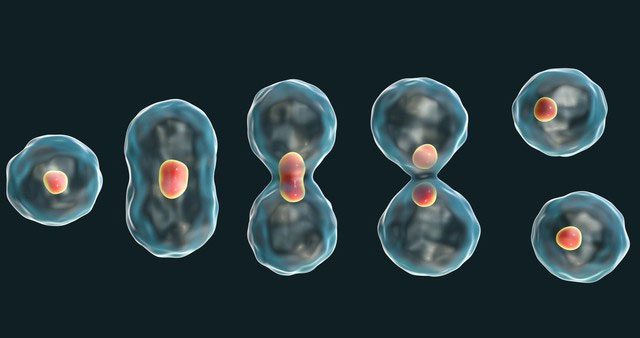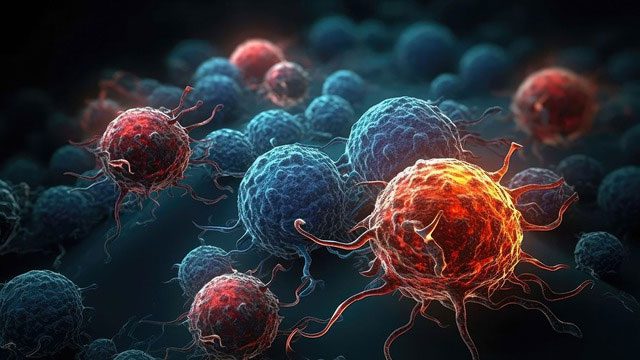The creation of cancer cells is a very complex process, requiring the coordination of many factors and the accumulation of numerous mutations that ultimately lead to the formation of cancer.
Cancer cells are actually normal cells in our body that have undergone certain changes, causing them to lose their regular function and ability to control normal processes. Under normal conditions, cells divide and die in an orderly manner according to the instructions of genes and health. However, sometimes errors occur in the genes of cells; these errors are known as mutations, which alter the characteristics and functions of the cells.
Most mutations are harmless, and some may even be beneficial for the adaptation and evolution of cells. However, some mutations can make cells harmful, and these mutations are the cause of cancer. Normally, most cells are “renewed” after a few days or months. Why do cells need to undergo this complex process to replace old cells and form new ones?

Cancer cells are actually normal cells in our body.
We need to understand an important concept – the cell cycle. The cell cycle refers to a series of stages through which cells progress from birth to division and death. Regulating the cell cycle is crucial for maintaining the normal function of tissues and organs. Through the orderly process of cell division and death, the body can regenerate and repair damaged tissues while maintaining a balanced number of cells. If cells lose control of the cell cycle, it can lead to abnormal proliferation and tumor formation.
Why can’t cells live forever? This relates to the life cycle of cells and the stability of genetic information. Each time a cell divides, the ends of the chromosomes lose a small amount of DNA due to the unique structure and function of the telomere. Telomeres are DNA-protein complexes located at the ends of chromosomes, serving to protect chromosomes from damage and instability. As the number of cell divisions increases, telomeres gradually shorten; when the length of the telomere reaches a certain threshold, the cell enters a stage known as “crisis.”
During a crisis, the telomeres of the cell become too short to provide adequate protection. This leads to abnormal fusion and damage of chromosomes, triggering the cell’s self-destruction mechanism. This self-destruction mechanism, known as “senescence” or “apoptosis,” ensures the elimination of damaged cells to prevent further development of abnormal cells.

Telomeres are DNA-protein complexes located at the ends of chromosomes.
However, not all cells die immediately after telomeres degrade. In some cases, cells may continue to divide, but these dividing cells will carry damaged DNA segments. Over time, the DNA damage in these cells accumulates, ultimately leading to cell death or functional decline.
Typically, the body’s immune system monitors and eliminates abnormal cells, including those with depleted telomeres. However, as lifespan increases and immune function declines, individual abnormal cells may escape the immune system’s control and begin dividing uncontrollably.
The appearance of mutated cells is not significantly different from that of normal cells; this disguise helps them evade attacks from the immune system and survive in quiet corners. They will grow silently until they reach the early stage of tumor formation. At this point, even if the immune system detects them, it cannot effectively combat them and can only passively allow them to grow and proliferate. During this phase, these mutated cell populations will hijack nutrients and space from their surroundings to meet their own growth demands. Consequently, tumors form.

External factors also contribute to cellular cancer.
Recent studies have shown that in addition to gene mutations, factors leading to cancer cells also have external causes. In their research, scientists discovered that the FOXR2 gene is often turned off in normal human tissues but is activated in at least 70% of various cancers and 8% of individual tumors.
These findings were published in the International Journal of Cancer. When researchers compared the genetic sequences of childhood brain cancer, they were surprised to find that many cancer patients had abnormally active FOXR2 genes. Normally, the FOXR2 gene is not expressed in any normal tissues except for the testes.
However, abnormal expression of FOXR2 has been found in many types of cancer, including bone cancer, malignant tumors, and lung cancer… The activity of the FOXR2 gene is even present in brain tumors such as diffuse midline glioma. Scientists believe that the expression of the FOXR2 gene helps accelerate the growth of brain tumors, including gliomas. Cells can activate the expression of this gene through a process called hypomethylation. When the FOXR2 gene is activated, a group of transcription factors known as ETS is overexpressed, which may promote tumor formation. In other words, the FOXR2 gene acts like a key that unlocks the door to cancer. Once the FOXR2 gene is active, the process of cellular cancer begins.

The immune system of most people effectively eliminates abnormal cells.
So, the question arises: are cancer cells only found in the bodies of patients? In fact, cellular mutations can sometimes occur in the bodies of healthy individuals, leading to the appearance of cancer cells. However, the immune system of most people effectively eliminates these abnormal cells, preventing them from developing into cancer.
Older individuals or those with weakened health are at relatively high risk of developing cancer due to impaired immune capacity and weakened screening of cancer cells. So why do cancer cells form tumors that pose a life-threatening risk to the host? Do they not realize that once the host dies, they will also perish? The reality is different; one study shows that most cells that become cancerous undergo changes during the aging process. During this period, cells have stopped dividing due to telomere shortening, and the body’s immune system will eliminate these cells.
Cells, like the human body, have a strong desire to survive. Driven by the instinct to survive, a few of these cells begin to proliferate and undergo infinite transformations, ultimately forming cancer cells. Although they are fully aware that if this situation continues, the host upon which they depend for survival will soon die, leading to the immediate extinction of their entire population, these cells are overwhelmed by instinct and cannot stop dividing. This is akin to humans and the Earth, where a small number of individuals control resources and privileges. Due to their desire for enjoyment and selfishness, they continuously exploit the Earth’s resources and destroy its environment. They may understand that these actions equate to the destruction of the Earth and the ruin of humanity’s future, but can they stop?





















































